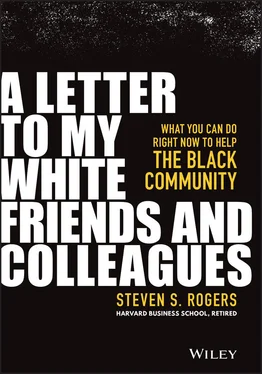Therefore, I am asking individuals to redress the problem primarily created by the government but that benefits White Americans. Your help is needed in the form of wealth sharing. I am not talking about a penalizing redistribution of wealth. I am recommending a wealth sharing that happens organically and intentionally via commerce, investments, savings, philanthropy, and government policy. This includes:
1 Spending money with Black-owned businesses.
2 Donating money to historically black colleges and universities (HBCUs).
3 Depositing money in Black-owned banks.
4 Supporting reparations.
I strongly believe that these means will eliminate the wealth gap and finally address fundamentally our country's racial problems practically and substantively.
My concern comes from my familial devotion to the improvement of the Black community and is the reason why I wrote this book that focuses on solutions to the problem of wealth disparity between Black and White Americans. It is my belief that until this problem is addressed in a systematic way, similar to the systemic anti-Black practices and policies that are its root causes, that the social unrest will continue. If peaceful coexistence is to exist between Blacks and Whites, the wealth gap, where the average White person has a net worth of $170,000 compared to $17,000 for the average Black person, must be eliminated. 1 This gap does not exist because Whites are smarter than Blacks, nor does it exist because Whites save more than Blacks or have worked harder than Blacks. These commonly held beliefs are falsehoods of mythic proportions, refuted by objective empirical research. 2
The reason for the racial wealth gap is simple, but barbaric. One scholar noted that slavery is the primary reason why Blacks hold 1% of the country's wealth today, compared to ½% immediately after slavery ended in 1865. 3 It stretches back to the moment those 20 abducted Black Africans were dragged to our shores in 1619, only 15 years after the first settlers landed in Jamestown, Virginia, in a ship called the White Lion . For 246 years, there were over 12 generations of zero wealth accumulation for Blacks, compared to the accumulation of hundreds of billions for Whites. The financial benefits to Whites were best described by a Duke University professor, Peter Wood, who said, “Slavery it seems to me was an extraordinary goose that laid the golden egg…. You had workers that you didn't have to pay, and you owned their children as soon as they were born. It's a preposterous system.” 4
American slavery was such a pervasive system in its enslavement and treatment of Blacks that financial wealth inured to the benefit of Whites whether an enslaved Black was alive or dead. Specifically, the financial benefits of enslaving Black people was ingrained in the fabric of almost every industry in the United States, including insurance, education, and banking. In the book and the movie 12 Years a Slave, we follow the story of Solomon Northup, a free Black man who was kidnapped and pressed into bondage. At a moment in the narrative when Northup was going to be lynched by a White employee on the plantation where he lived, a bank mortgage ended up being a primary reason why his life was spared. Another White plantation employee stopped the hanging because killing Northup would have resulted in the bank expecting immediate repayment of a $400 loan. Northup's Black life mattered only because a bank was owed money.
When we think of mortgages, we imagine banks providing loans to buy inanimate assets such as real estate, but during slavery, the White banking industry expanded their mortgage portfolios by providing loans to buy Black people as well as issuing new loans using Black enslaved people as collateral to buy more Black people. This is similar to a homeowner who owns her home free and clear getting a new mortgage. Therefore, banks in the north and south made more profits from mortgages on human beings than on real estate. Historian Bonnie Martin found that in some states, there were periods when slaves served as partial collateral for more than 80% of all loans. 5 At one time in Louisiana, the frequency with which owners used enslaved Blacks as collateral for loans approached 90%. 6
Those men and women who did not escape death, like Northup, still had value. For example, it has recently been discovered that major medical schools used the corpses of Black enslaved people for research, anatomy classes, and dissection. This was called the “domestic cadaver trade” and participating schools included Harvard University, the University of Maryland, the University of Pennsylvania, and the University of Virginia. The prices paid for the cadavers, as reflected in the records of the schools that kept payment schedules, was $12 for adults, $15 for mothers and their infants, and $8 for children between the ages of 4 and 10. Often, these bodies were stolen from cemeteries. 7
Another industry that profited from deceased Black enslaved people was the insurance industry. It was common for insurance companies to provide coverage to slave owners and slave ships. In the book Zong! by Canadian writer M. NourbeSe Philip, the author extrapolated from legal documents that 150 Africans on one slave ship were purposely drowned, so that the owners could collect insurance monies for the loss. 8
Over 78 years after this horrific terminal fraud, Cudjo Lewis was reported to have been one of the last Africans transported to America as an enslaved man. He was one of the enslaved people on a ship called the Clotilda, which arrived in America in 1859, 50 years after the federal government had abolished the slave trade in this country. 9 This was a federal crime.
After the human cargo of 110 Black men and women departed the ship, it was purposely burned and sunk. The Meaher family, who had financed the illegal kidnapping, had the ship destroyed so as not to retain evidence of their crime. But in 2019, the ship was discovered in the murky waters of Montgomery, Alabama, not far from where Lewis had deboarded 60 years earlier. 10
After almost two and a half centuries of his people being held in bondage and working with no compensation, generation after generation, this is what Lewis said when informed that he was free, and no longer an enslaved man owned by Tim Meaher and his family: 11
It April 12, 1865. De Yankee soldiers dey come down to de boat and eatee de mulberries off de trees. Den dey see us and say, “Y'all can't stay dere no mo'. You free, you doan b'long to nobody no mo. Oh, Lor'! I so glad. We astee de soldiers where we goin'? Dey say dey doan know. Dey told us to go where we feel lak goin', we ain' no mo' slave.
Afterwards, Mr. Lewis had the following discussion with Tim Meaher, his former slave owner:
Cap'n Tim, you brought us from our country where we had lan'. You made us slave. Now dey make us free but we ain' got no country and we ain' got no lan'! Why doan you give us piece dis land so we kin buildee ourself a home? Cap'n jump on his feet and say, “Fool do you think I goin' give you property on top of property? I tookee good keer my slaves and derefo' I doan owe dem nothin. You doan belong to me now, why must I give you my lan'?
In 2020, on a segment on the television show 60 Minutes about discovering the sunken Clotilda slave ship, it was reported that the Meaher family, descendants of “Cap'n Tim,” owns land, businesses, and other assets worth over $26 million. 12
This unwillingness to help the newly freed people, during what author Saidiya Hartman called “the afterlife of slavery” was a common refrain by individuals, as well as the government. Field Order No. 15 was issued in January 1865. This military order was intended to take 400,000 acres of land confiscated from confederate soldiers who were found guilty of treason and to disperse it to people who were formerly enslaved. 13 Unfortunately, President Andrew Johnson said this was advantaging Blacks over Whites and that it was time for Blacks to fend for themselves. In a speech he said, “It is earnestly hoped that instead of wasting away they will by their own efforts establish for themselves a condition of respectability and prosperity.” 14
Читать дальше











